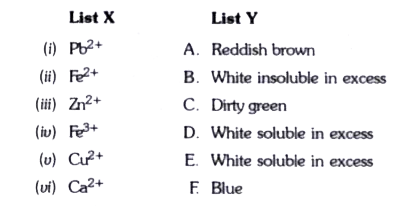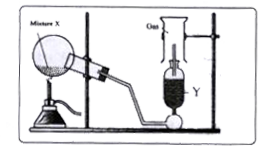Complete Solutions to SECTION-II of chapter CHEMISTRY 2011 of Class 10 book with complete answers and questions
| Class 10 | CHEMISTRY |
| Chapter | CHEMISTRY 2011 |
| GURUKUL PUBLICATION | SECTION-II |
| Number Of Questions | 48 |
| Academic Year | 2023-24 |
Differentiate between electrical conductivity of copper sulphate solution and copper metal .
02:48View SolutionSodium hydroxide solution is added to the solutions containing the ions mentioned in List X. Use Y gives the details of the precipitate. Match the ions with their coloured precipitates.
 01:58View Solution
01:58View SolutionDuring the electrolysis of copper (II) sulphate solution using platinum as cathode and carbon as anode :
What do you observe at the cathode and at the anode ?06:25View SolutionDuring the electrolysis of copper (II) sulphate solution using platinum as cathode and carbon as anode :
What change is noticed in the electrolyte?03:52View SolutionDuring the electrolysis of copper (II) sulphate solution using platinum as cathode and carbon as anode :
Write the reactions at the cathode and at the anode.05:27View SolutionName a metal which is found abundantly in the earth's crust.
01:37View SolutionWhat is the difference between calcination and roasting?
03:04View SolutionName the process used for the enrichment of sulphide ore.
02:09View SolutionWrite the chemical formulae of one main ore of iron and aluminium .
01:36View SolutionWrite the constituents of electrolyte for the extraction of aluminium.
01:50View SolutionThe diagram shows an experimental set up for the laboratory preparation of a pungent smelling gas. The gas is alkaline in nature.

Name the gas collected in the jar.01:40View SolutionThe diagram shows an experimental set up for the laboratory preparation of a pungent smelling gas. The gas is alkaline in nature.

Write the balanced equation for the above preparation.01:13View SolutionThe diagram shows an experimental set up for the laboratory preparation of a pungent smelling gas. The gas is alkaline in nature.

How is the gas being collected ?01:06View SolutionThe diagram shows an experimental set up for the laboratory preparation of a pungent smelling gas. The gas is alkaline in nature.

Name the drying agent used.02:07View SolutionThe diagram shows an experimental set up for the laboratory preparation of a pungent smelling gas. The gas is alkaline in nature.

How will you find that the jar is full of gas?02:16View SolutionAn organic compound with vapour density = 94 contains
C=12.67%, H = 2.13%, and Br = 85-11%. Find the molecular formula.
[Atomic mass: C = 12, H = 1, Br = 80]05:16View SolutionCalcuate the mass of
`10^(22)` atoms of sulphur.
[ Atocmi mass S=32,C and O=16 and Avogadro's number `=6xx10^(23)`]01:14View SolutionCalculate the mass of
0.1 mole of carbon dioxide.
[Atomic mass : S = 32, C = 12 and O = 16 and Avogadro.s Number = `6 xx 10^(23)`]01:50View SolutionIn the laboratory preparation of hydrochloric acid, HCl gas is dissolved in water.
Draw a diagram to show the arrangement used for the absorption of HCI in water.03:17View SolutionIn the laboratory preparation of hydrochloric acid, HCl gas is dissolved in water.
Why is such an arrangement necessary ? Give two reasons.03:21View SolutionIn the laboratory preparation of hydrochloric acid, HCl gas is dissolved in water.
Write the chemical equations for the laboratory preparation of HCl gas when the reactants are:
(A) below `200^@C` (B) above `200^@C`02:35View SolutionIn the laboratory preparation of hydrochloric acid, HCl gas is dissolved in water.
Write the chemical equations for the laboratory preparation of HCl gas when the reactants are:
(A) below `200^@C` (B) above `200^@C`02:35View SolutionChoose the correct word/phrase from within the brackets to complete the following sentences :
The catalyst used for conversion of ethene to ethane is commonly ............
(nickel / iron / cobalt)03:25View SolutionWhen acetaldehyde is oxidised with acidified potassium dichromate, it forms _____(ester/ethanol/acetic acid)
01:47View SolutionChoose the correct word/phrase from within the brackets to complete the following sentences :
Ethanoic acid reacts with ethanol in presence of concentrated `H_2SO_4`, so as to form a compound and water. The chemical reaction which takes place is called.... (dehydration / hydrogenation / esterification)02:12View SolutionChoose the correct word/phrase from within the brackets to complete the following sentences :
Write the equation for the reaction taking place between 1, 2-dibromoethane and alcoholic potassium hydroxide.02:20View SolutionChoose the correct word/phrase from within the brackets to complete the following sentences :
The product formed when ethene gas reacts with water in the presence of sulphuric acid is ........ (ethanol / ethanal / ethanoic acid)02:56View SolutionWrite balanced chemical equations for the following:
Monochloro ethane is hydrolysed with aqueous KOH01:52View SolutionWrite balanced chemical equations for the following:
A mixture of soda lime and sodium acetate is heated.02:11View SolutionWrite balanced chemical equations for the Ethanol under high pressure and low temperature is treated with acidified potassium dichromate.
02:23View SolutionWrite balanced chemical equations for the following:
Water is added to calcium carbide.01:34View SolutionWrite balanced chemical equations for the following:
Ethanol reacts with sodium at room temperature.01:13View SolutionWith the help of equations, give an outline for the manufacture of sulphuric acid by the contact process.
03:14View SolutionWhat property of sulphuric acid is shown by the reaction of concentrated sulphuric acid when heated with
(A) Potassium nitrate
(B) Carbon ?02:48View SolutionWhat property of sulphuric acid is shown by the reaction of concentrated sulphuric acid when heated with
(A) Potassium nitrate
(B) Carbon ?02:48View SolutionWhat is the special feature of the apparatus that is used in the laboratory preparation of nitric acid?
01:38View SolutionWhy should the temperature of the reaction mixture of nitric acid not be allowed to rise above `200^@C`?
03:45View SolutionWrite balanced chemical equation for the following: Chlorine reacts with excess of ammonia.
05:26View SolutionWrite balanced chemical equation for the following: Ferric hydroxide reacts with nitric acid.
02:03View SolutionWrite balanced chemical equation for the following :
Zinc oxide dissolves in sodium hydroxide.03:31View SolutionGive the number of the group and the period of the element having three shells with three electrons in the valence shell.
01:05View SolutionBy drawing an electron dot diagram, show the lone pair effect leading to the formation of ammonium ion from ammonia gas and hydrogen ion.
03:47View SolutionWhat happens to the crystals of washing soda when exposed to air ? Name the phenomenon exhibited.
01:25View SolutionName the method used for preparation of the following salt from the list given below :
List : (A) Simple displacement
(B) Neutralization
(C) Decomposition
(D) Double displacement
(E) Direct synthesis.
Sodium hydrogen sulphate04:31View SolutionName the method used for the preparation of the following salts from the list given below:
(i) Sodium nitrate
(ii) Iron(III) chloride
(iii) Lead chloride
(iv) Zinc sulphate
(v) Sodium hydrogen sulphate
List: (A) Simple displacement
(B) Neutralisation
( C) Decomposition by acid
(D) Double decomposition
(E) Direct synthesis.05:07View SolutionName the method used for the preparation of the following salts from the list given below:
(i) Sodium nitrate
(ii) Iron(III) chloride
(iii) Lead chloride
(iv) Zinc sulphate
(v) Sodium hydrogen sulphate
List: (A) Simple displacement
(B) Neutralisation
( C) Decomposition by acid
(D) Double decomposition
(E) Direct synthesis.05:07View SolutionName the method used for preparation of the following salt from the list given below :
List : (A) Simple displacement
(B) Neutralization
(C) Decomposition by acid
(D) Double decomposition
(E) Direct synthesis.
Zinc sulphate01:41View SolutionName the method used for preparation of the following salt from the list given below :
List : (A) Simple displacement
(B) Neutralization
(C) Decomposition
(D) Double displacement
(E) Direct synthesis.
Sodium hydrogen sulphate04:31View Solution
SECTION-II questions and complete solutions for chapter CHEMISTRY 2011 of EVERGREEN CHEMISTRY (ENGLISH) of Class 10
